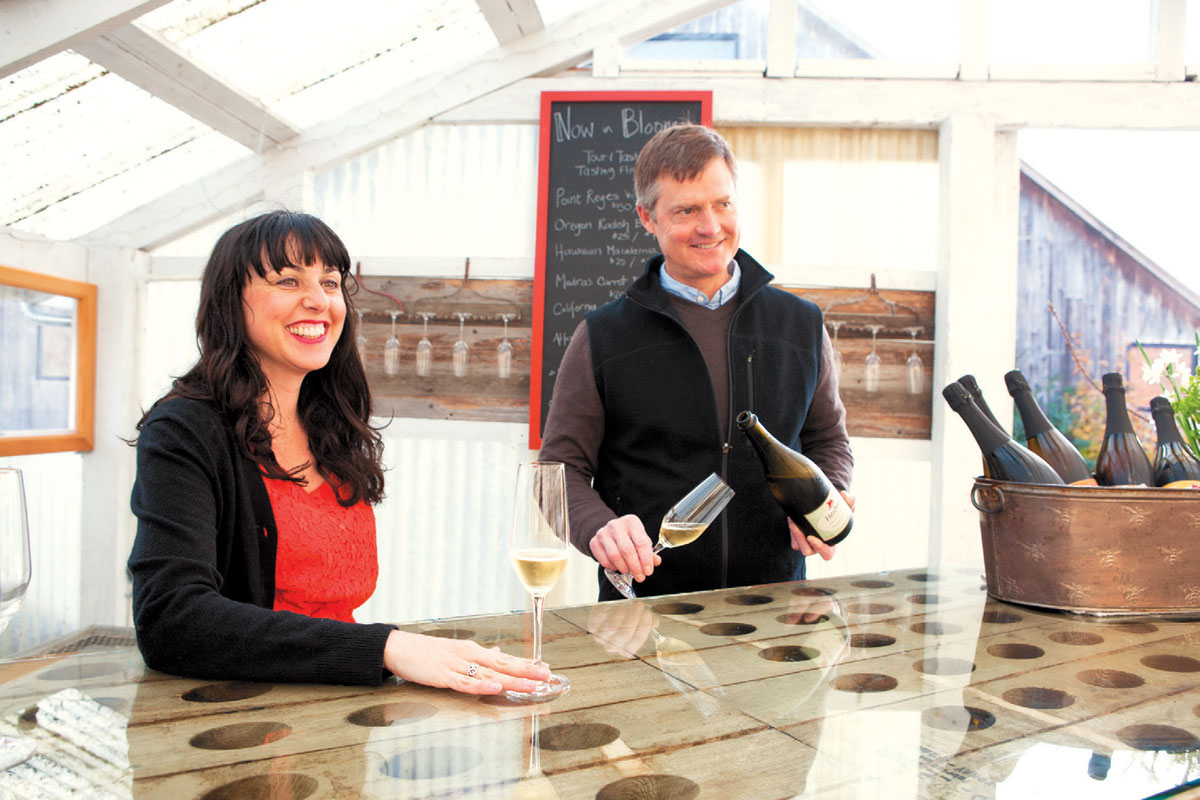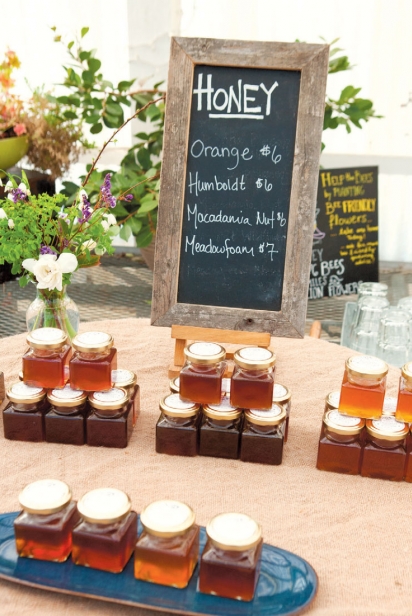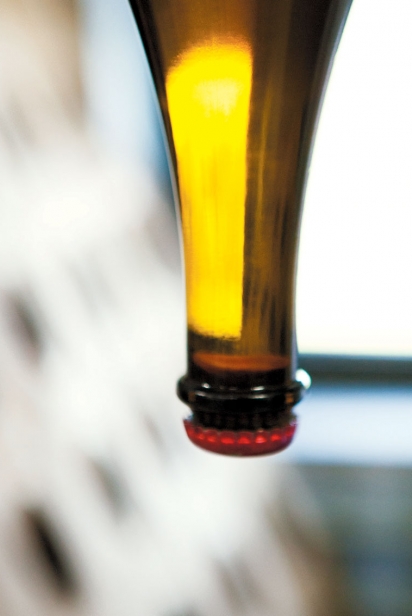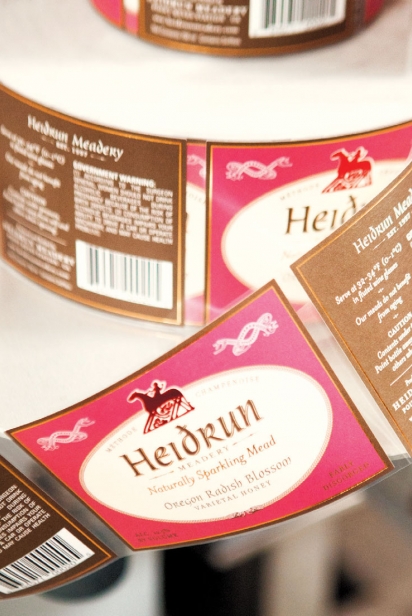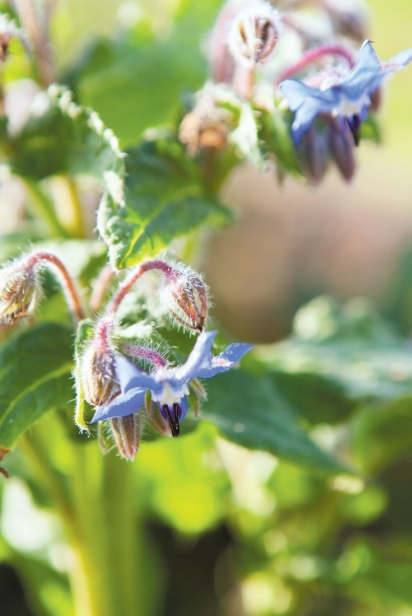Thoroughly Modern Mead
Local mead maker crafts ancient beverage for 21st century palates
MEAD, THE ANCIENT ELIXIR
Mead is a potent potable largely unrecognizable to 21st century drinkers. A fermented beverage traditionally derived from honey, water and any wild yeast that came to rest on top of the brew, mead has been the beverage of choice for most of Europe, the Middle East, India, Africa and beyond since the days of the ancients.
The earliest reference to mead as a revered object may be from the Rigveda (1700–1100 BCE, or Before the Common Era). This sacred Indo-Aryan collection of Sanskrit hymns chronicles mythical accounts of the world’s origins and contains countless hymns and prayers for gods, bees, honey and mead.
To the north and west, from the land of the Egyptians to the land of the Celts, mead is deeply ensconced in the mythology of European and African cultures. Known as “the wine of truth,” mead is celebrated in song and lore for its health-giving properties (including increased virility) and ability to confer on humans some of the immortality of the gods.
At about the same time as the Rigveda memorialized the Indo-Aryan culture’s reverence for honey, bees and mead, Ethiopian legend also has it that, among other extravagant gifts, the Queen of Sheba brought King Solomon royal mead, or honey fermented with buckthorn, during a diplomatic mission.
Among the Irish, mead’s place was so central to the culture that Tara, the home of the High Kings of Ireland, was called the House of the Mead Circle. Irish saints partook of mead. Saint Findian lived on bread and water for six days a week, but on Sundays he ate salmon and drank mead. A popular story about Saint Brigit (451–523 CE) states that a blessing she bestowed upon empty vessels, prior to a visit by the King of Leinster, filled the jugs with mead.
In southern Europe, the god of wine known as Bacchus to the Romans and Dionysus to the Greeks, carried a thyrsus or staff tipped with a pinecone and dripping with honey. It was only in the Middle Ages, when mead diminished in popularity with the rise of wine and ale production, that Bacchus came to be known as the god of wine. Ritual madness (drunkenness) and fertility were, at first, associated with mead. Mead maintains its place of honor and mythology through the first half of the Middle Ages. Taliesin, a Welsh bard and contemporary of the legendary King Arthur (late fifth and early sixth century), sang the praises of mead in a plea to the king to release his master from prison:
“I adore the Supreme, Lord of all animation—Him that supports the heavens, Ruler of every extreme,
Him that made the water good for all,
Him who has bestowed each gift, and blesses it; May abundance of mead be given … who supplies us,
From his foaming meadhorns, with the choicest pure liquor,
Since bees collect and do not enjoy,
We have sparkling distilled mead which is universally praised.”
Composed in 700 CE, Beowulf, the epic Old English poem set in Scandinavia, discussed the hall where kings banqueted, known as the Mead Hall, where mead and ale are served to Beowulf in a special mead bowl.
Similarly, a bowl of wine or mead or ale passed around at Christmastime came to be known as wassail, from the Old English toast meaning “be whole” and “be of good health.”
A RENAISSANCE
Gordon Hull, proprietor of Heidrun Meadery in Point Reyes Station, did not set out to make mead. A geologist by trade, Hull had a fondness for beer, so much so that he learned how to brew his own.
Eventually his home brewing “hobby” grew into such a passion that, in the early 1990s, Hull left geology to work with the American Brewer’s Guild and, after an internship with a brew master, he went on to brew beer for Eureka’s celebrated Lost Coast Brewery.
A lover of organic chemistry, Hull wasn’t content to stop experimenting and learning, and he eventually found himself tinkering with that most ancient elixir, mead. But the contemporary meads Hull had tasted were not what he was after.
“I wanted to make mead that was less sweet,” he said. “I wanted it to be more like beer—drier and bubblier.” The results, by Hull’s own estimation, were surprisingly good, so he kept tinkering.
Hull says what he noticed with every new batch of mead was the expression of the unique flavors of each honey varietal in the finished beverage. He continued experimenting with different honeys and, before long, a small business had started.
“Our first customer was [San Francisco’s] Greens in 1995, then Chez Panisse and the French Laundry,” he recalls. After a few customers contacted Hull to discuss the naturally occurring yeast sediment in the mead that would remain in their patrons’ glasses, Hull had the idea to apply the traditional French methode champenoise (Champagne method), a series of steps practiced by grape winemakers to remove these unwanted solids, to his mead.
But first he had to learn how to do that. Back to the classroom, Hull taught himself how to “riddle” these sediments down to the neck of each bottle of mead after a secondary fermentation, and then “disgorge” them. Thusly, a thoroughly modern style of mead was born.
A MEADERY IN WEST MARIN
Hull and his family moved to Point Reyes from Humboldt County in 2008, purchasing a former dairy farm just north of town on Highway 1. Construction of a meadery on the property began soon thereafter and was completed in 2011.
Hull currently crafts five to eight different flavors of mead, depending on the availability of certain of the single-varietal honeys he prefers.
In keeping with ancient mead-making tradition, Hull first mixes his chosen honey with water in order to reduce the sugar concentration and facilitate fermentation. Hull refers to this as the “brewing” stage of the process.
Unlike many commercial mead makers, Hull then brings the honey water, or “must,” to a rolling boil for just 15 minutes before flash cooling it during transfer out of the kettle and into stainless steel fermentation tanks. The boil helps to achieve greater mead clarity and allows Hull to avoid the use of sulfites, which he disdains.
At this point, the brewing stage is complete and Hull begins the unorthodox (in mead making circles) methode champenoise process, pitching (a term of art in the mead-making world, not just Hull’s particular mode of adding the yeast) a specifically chosen Champagne yeast into the must to enable fermentation. This primary fermentation typically lasts 10 days, after which the liquid in the tank may truly be called honey wine or mead—but there are still numerous stages before Hull’s process of crafting sparkling mead is complete.
After primary fermentation, the mead is allowed to rest for a month before it is bottled. After bottling, according to the methode champenoise, the bottles are laid on their sides in tirage bins (large wooden storage boxes) where they spend two months going through the secondary fermentation necessary to create their natural effervescence. From a chemistry standpoint, during this second fermentation the yeast in the bottle is consuming the residual sugars in the mead, releasing carbon dioxide as a byproduct—aka the “tiny bubbles.”
Unlike Champagne producers, however, Hull does not age his meads sur lee, employing instead the practice of “early disgorgement” in which the sediment from the secondary fermentation (the “lees”) is removed as promptly as possible after that fermentation is complete.
“We early disgorge to minimize the contribution of the yeast to the character of the mead,” Hull says, “because our focus is on revealing the natural essence of the honey from which the mead is made, and nothing else.” It is for this reason as well that Hull does not employ the common Champagne process step of adding a dosage—or liqueur—to his meads.
Disgorging is no simple task. First, each bottle must be “riddled” (the slow and lengthy process of migrating yeast sediment from the side to the neck of the bottle) and then the sediment must be extracted using specialized sparkling wine equipment. Hull still riddles his estate varietals by hand but relies on an automated riddler for most other varietals. In all, it takes Hull about four months to produce a single batch of his naturally sparkling mead.
ADDING TO ANCIENT TRADITIONS
Hull is clearly adding his own California chapter to the epic mead myths and stories that span continents and ages while continuing their great legacy. The name Hull chose for his meadery is a case in point.
While researching the long history of mead, Hull dug into the writings of Snorri Sturluson, 13th-century Icelandic historian and poet who penned an important work of Norse mythology. The central story of the Norse gods tells of a world wrapped around an ash tree. Within this world, Odin, father of the Norse gods, built a glowing hall, Valhalla. Carried to Valhalla by the Valkyries, Odin’s warrior goddesses, fallen gods and heroes refreshed themselves on roasted boar and a never-ending stream of mead from the udders of a magic goat, Heidrun, who ate the leaves of the great ash tree. The Nordic connection resonated with Hull, and Heidrun Meadery was born.
Aptly, the current Heidrun is situated on land that was once a dairy farm.
IT’S ALL ABOUT THE BEES
Whatever its magical or immortality-imparting qualities, mead inherently relies on bees and their ability to “manufacture” honey. There is a natural seasonality to the availability of particular pollens and nectars and, accordingly, to each honey varietal. Honeys including radish blossom honey, carrot blossom honey and orange blossom honey, sourced from Nature’s Best Oregon Honey, and macadamia nut blossom honey sourced from Hawaii, arrive at Heidrun at their own bee-determined times of the year.
In previous years, Hull has made mead with sage blossom honey and with avocado blossom honey, but the ongoing drought and the uniqueness of their plant ecology means that these varietals have not been produced in recent years by the bees. Why? Native to the Sierra foothills, “sage will not blossom unless they get 13 inches of rain at the end of spring,” said Hull.
The case of avocado blossom honey is even less certain. Hull had previously sourced avocado blossom honey from the area around Ventura. His source there has recently reported that the bees are pollinating the plants and collecting pollen, but honey is not being produced. “I have not been able to purchase either of these honeys in three or four years,” said Hull.
Beekeepers are, of course, concerned about the widespread Colony Collapse Disorder (CCD) but the regional drought in our area has placed additional stress on bees. As with the Sierra foothills sage, water is an important component of plant health and its reduction limits the amount of forage available to bees. “Bees use water to keep their hives cool,” said Hull, and the reduction of water in the environment, due to drought or other factors, can negatively impact hive health.
Hull has taken a series of steps to mitigate some of these environmental risks. A few years ago, when CCD was suspected in the demise of Heidrun’s own hives, Hull worked with a commercial beekeeper, Mark Johnson of Nature’s Best Oregon Honey, to learn how to transition his apiaries from “hobby level to commercial level.”
He also brought on Brad Alpert to manage the meadery’s own 65 hives, set in eight apiaries all located within 30 miles of Heidrun.
On the ground level, the open fields of the former dairy farm are, under the care of Heidrun’s horticulturalist/farmer Jordan Thompson, being transitioned to a large vegetable garden, a series of fruit orchards and fields of wild and bedded flowers. A creek that runs through the property is on its way to becoming a rich riparian zone, adding additional habitat biodiversity and a small wetland to the dry ranchland.
“Beekeeping is still as perplexing as it was before,” says Hull, but taking these steps to support the bees also improves the overall quality of the local environment and, naturally, the future of Heidrun.
Through the efforts of Hull and other modern mead makers, a much-revered ancient beverage is finding new expression and a place at 21st century tables.
Santé!
For more in depth information about the history of mead and how to brew your own, the author recommends Brewing Mead: Wassail! In Mazers of Mead: The Intriguing History of the Beverage of Kings and Easy, Step-by-Step Instructions for Brewing It At Home by Robert Gayre and Charlie Papazian (Brewers Publications, 1986) from which much of the historical information in this piece was sourced.
FIND HEIDRUN’S MEAD
HEIDRUN MEADERY
11925 State Hwy. 1, Point Reyes Station
Open for tastings and tours M–Sa, 10am–4pm. Advance reservation required. Same day reservations accepted. 415.663.9122; HeidrunMeadery.com
AND IN THESE RESTAURANTS AND RETAIL LOCATIONS:
In Marin: Bolinas Market, Cowgirl Creamery/Tomales Bay Foods, Hog Island Oyster Company (the Farm in Tomales), Marin Sun Farms, Mill Valley Market, Nick’s Cove, Osteria Stellina, Palace Market, Paradise Foods, Perry’s Deli, Sir & Star, Station House Café, Stinson Beach Market, Whole Foods Markets (all locations), Paradise Foods and Taste Kitchen and Table (Fairfax)
In Sonoma: Bottle Barn, Central Market, Healdsburg SHED, Lagunitas Brewing, Oliver’s Markets, Speakeasy Petaluma, Whole Foods Markets (all locations) and Wilibees Wine & Spirits
In Napa: City Winery and Whole Foods Market
TASTING NOTES AND SUGGESTED PAIRINGS WITH LOCAL CHEESES
Hawaiian Macadamia Nut Honey Mead
Ale color, nutty, noticeable yeast notes
PAIR WITH: Point Reyes Farmstead Cheese Company’s Toma, a creamy, semi- Hard cow cheese with a grassy, tangy finish. The nuttiness in the cheese and in the mead enhances the character of each. Also a great partner with oysters.
Madras Carrot Blossom Honey Mead
Tastes like Saison beer, ale color, aromas of sandalwood
PAIR WITH: Weirauch Farm & Creamery’s Blue Lupine, a 3-month-aged blue goat cheese. “Blue cheeses don’t generally pair well with our meads,” Hull said, “but the Blue Lupine is creamy and far milder than typical blues, while the Carrot Blossom is an audacious varietal brimming with notes of incense, earth and flower.”
California Orange Blossom Honey Mead
Pale yellow, minerals on the nose, floral and yeast notes
PAIR WITH: Cowgirl Creamery’s Mt. Tam, an elegant triple cream cow cheese with hints of butter and white mushroom. This partnership balances citrus and cream notes in the cheese and in the mead. Also a great partner with oysters.
Alfalfa and Clover Blossom Honey Mead
Pale yellow, floral, softer on the palate, summery, tastes of peaches
PAIR WITH: Gypsy Cheese’s Caravan Gold, a tangy raw goat milk feta marinated in olive oil and fresh herbs. The fruit flavors in the mead riffs off of the goat’s naturally sour character.
Estate-made Point Reyes Wildflower Honey Mead
Subtly herbal, elegant
PAIR WITH: Tomales Farmstead Cheese Company’s Atika, a blend of aged goat and sheep cheese. The cheese’s soft acidity balances the soft herbal notes of the mead.
Slowly, steadily, ale derived from honey (known as bracket in Celtic countries) or from mead gave way to ale derived from grain as the Egyptian practice of malting grain moved throughout Europe.
Mead’s decline can be traced to as early as the fifth century, when malted and fermented grain was already in general use for brewing in Germany. The subsequent rise of less expensive, equally intoxicating ale, beer and, later, grape wine, led to a slow and steady shift of popular culture away from mead. Thereafter, cultural sources and mythology often blend the meaning of mead and ale.


